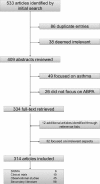Allergic bronchopulmonary aspergillosis in patients with cystic fibrosis
- PMID: 28469716
- PMCID: PMC5399694
- DOI: 10.4103/atm.ATM_231_16
Allergic bronchopulmonary aspergillosis in patients with cystic fibrosis
Abstract
Allergic bronchopulmonary aspergillosis (ABPA) is a pulmonary disorder that often occurs in patients with asthma or cystic fibrosis (CF) and is characterized by a hypersensitivity response to the allergens of the fungus Aspergillus fumigatus. In patients with CF, growth of A. fumigatus hyphae within the bronchial lumen triggers an immunoglobulin E (IgE)-mediated hypersensitivity response that results in airway inflammation, bronchospasm, and bronchiectasis. In most published studies, the prevalence of ABPA is about 8.9% in patients with CF. Since the clinical features of this condition overlap significantly with that of CF, ABPA is challenging to diagnose and remains underdiagnosed in many patients. Diagnosis of ABPA in CF patients should be sought in those with evidence of clinical and radiologic deterioration that is not attributable to another etiology, a markedly elevated total serum IgE level (while off steroid therapy) and evidence of A. fumigatus sensitization. Management of ABPA involves the use of systemic steroids to reduce inflammation and modulate the immune response. In patients who do not respond to steroids or cannot tolerate them, antifungal agents should be used to reduce the burden of A. fumigatus allergens. Recent studies suggest that omalizumab may be an effective option to reduce the frequency of ABPA exacerbations in patients with CF. Further randomized controlled trials are needed to better establish the efficacy of omalizumab in managing patients with CF and ABPA.
Keywords: Allergic bronchopulmonary aspergillosis; allergic fungal mycosis; cystic fibrosis.
Conflict of interest statement
There are no conflicts of interest.
Figures


References
-
- Strausbaugh SD, Davis PB. Cystic fibrosis: A review of epidemiology and pathobiology. Clin Chest Med. 2007;28:279–88. - PubMed
-
- Riordan JR. The cystic fibrosis transmembrane conductance regulator. Annu Rev Physiol. 1993;55:609–30. - PubMed
-
- Sheppard MN, Nicholson AG. The pathology of cystic fibrosis. Curr Diagn Pathol. 2002;8:50–9.
-
- Bains SN, Judson MA. Allergic bronchopulmonary aspergillosis. Clin Chest Med. 2012;33:265–81. - PubMed
Publication types
LinkOut - more resources
Full Text Sources
Other Literature Sources

